Flower bed decoration with roses
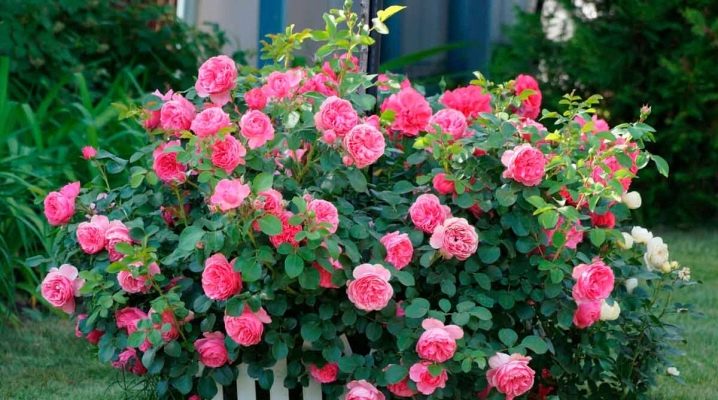
Roses do not leave indifferent any gardener. Due to their variety of shapes, sizes and colors, these gorgeous flowers fit into almost any floral arrangement in landscape design. These gorgeous flowers can add charm to even the most ordinary-looking area or flower garden. Rose bushes are used in landscape design for various design options for flower beds, arches, rabatki and gazebos. No wonder the rose is called the queen of flowers. But when planning a rose garden or an intricate flower bed on your site, you need to think over all the details of planting and choose the right varieties of roses and neighboring plants.
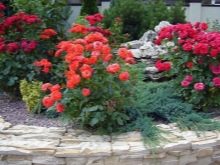

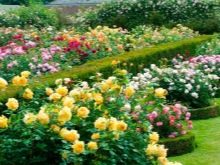
Variety selection
To create beautiful patterns and compositions in flower beds, erect flower varieties with a compact bush shape are best suited. The rose in the flowerbed should be the accent, and the rest of the plants should create the background for it. It is good when the flower variety has a long flowering period, and the flowers are located along the entire height of the stem.
The following types of plants are suitable for a rose garden:
-
standard;
-
polyanty;
-
floribunda;
-
miniature;
-
grandiflora.
Climbing varieties are suitable for decorating hedges in private houses or gazebos on personal plots. Roses, like no other plants, are suitable for decorating gazebos and arches in landscape design.
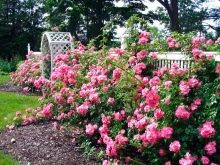
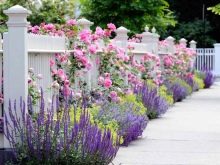
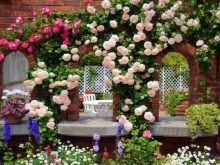
And their wonderful aroma will be in the air all summer long. Climbing varieties go well with groundcover or hybrid tea varieties, making the composition more interesting and intricate. Climbing roses will also help to arrange a vertical structure or a hedge on the site. They look good both as single bushes and in the vicinity of other plants.
For areas with slopes, groundcover and climbing plant varieties are better suited. Their flowers are located closer to the ground, a solid carpet of roses of different colors will look spectacular. In this case, it is recommended to strengthen long flexible shoots on the ground with special braces.
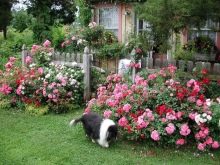
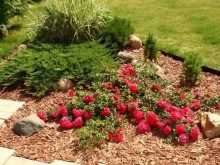
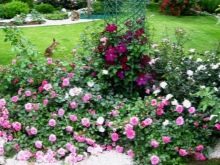
For the framing of the tracks, it is better to choose varieties without thorns, to make it easier to walk around the site and take care of flowers. And in the second row, you can plant tall varieties of a different color.
From the edge of the path, the first row of plants should be planted at a distance of at least 50 cm.Do not choose varieties that grow quickly and strongly, in which case they can interfere with moving along the paths, and without growth control they will capture the entire area.
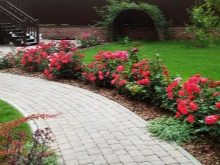
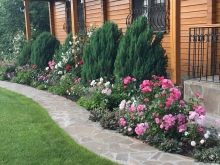
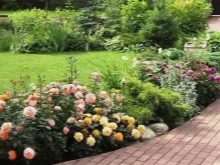
Color combinations
When creating a rose garden or mixed flower bed be sure to select the types of plants whose buds are combined in color and shape... Then the flower garden will look harmonious and pleasing to the eye. Landscaping experts advise planting several different bushes in one flower bed, 3-5 pieces of each type. For example, bright red and scarlet flowers must be shaded with cream or pale yellow colors. Pink flowers do not go well with scarlet.
When choosing flowers for a future flower bed, focus on warm or cold colors. Colors in the same range are better combined with each other, and the flower bed will not look awkward, as if it was collected from what was found.
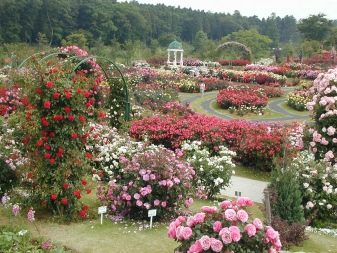
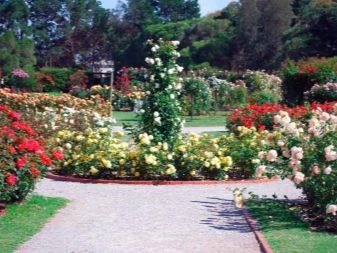
As for the combination of roses with other types of plants, reds are combined with white and green flowers, and pink with blue (sky-colored) or lilac. Scarlet roses are categorically not combined with orange and pink flowers, although they are in the same color spectrum.
Plants of the varieties "Novalis", "Bolero", "Iceberg", "Flamingo" and "Elina" are best suited for decorating a flower bed or a rose garden in the country. They bloom in white, light pink and delicate red flowers, which will bring nobility to the site.
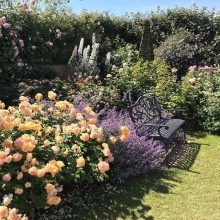

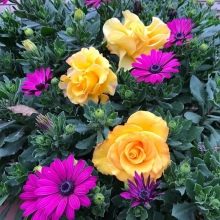
What can you plant with?
Flower beds with roses are good to complement with other types of plants. Annual flowers are often used for this. Roses look good with plants that have an earlier flowering period. So the flower bed will delight with flowering all summer. At first, neighboring one-year-olds will bloom, and then it will be the turn of roses. So the flowers will replace each other until the fall. Violets, phloxes, vervains or ordinary ivy can be planted as such neighbors. Of perennial plants, bulbs, cereals and dried flowers are well combined with roses. On the same site with roses, conifers, barberries and clematis get along well. A combination of standard varieties of roses with thujas in one area is considered a classic. Roses feel good under reliable protection from the wind and in partial shade from tall thujas.
Roses do not coexist well with salvia, garden geranium, calceolaria, tagetes and other bright flowers. The scent of flowers does not quite match with bulbous lilies in roses. And the beauty of the rosebuds and lilies will compete and interrupt each other. But if you really want to put them together, then it is better to choose red roses and white lilies - this will be the most harmonious combination possible.


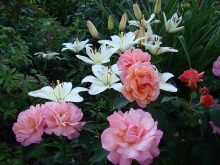
With other colors
You can combine rose bushes with almost any annual plant. The main rule is to plant other types of plants at a distance of at least 0.5 m from the rose bushes... Otherwise, the rose will simply crush other plants and prevent them from growing.
When choosing neighbors, it is imperative to take into account the period of their flowering, it is better when it does not coincide with the flowering of the rose, then the flower bed will always be in flowers.

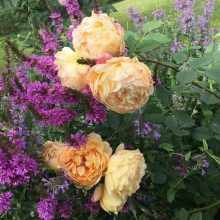
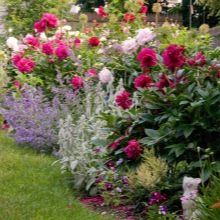
With conifers and other ornamental shrubs
The combination of rose bushes with conifers (spruce, thuja, juniper) in landscape design is considered classic. And also the rose gets along well with rosehip, acacia and lilac bushes.
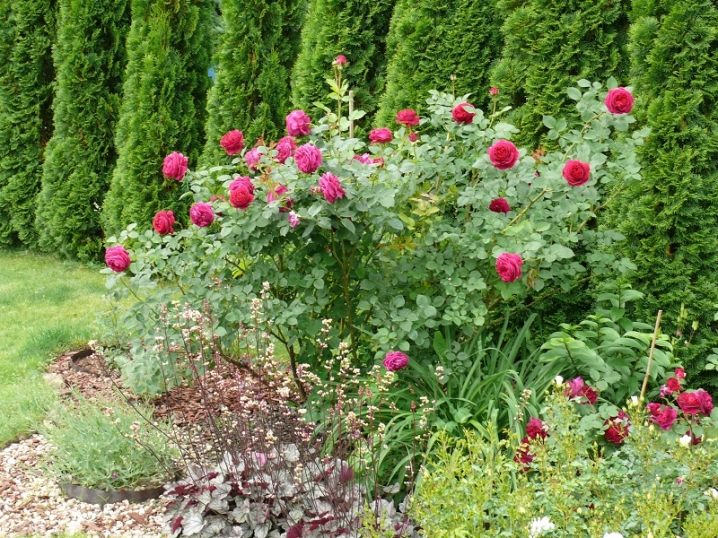
With other roses
Different varieties of roses feel good next to each other. The main thing is to choose the matching colors, shape and size of flowers of various varieties. It is better to plant bushes in a checkerboard pattern at a distance of 0.5-1 m from each other. Use 3-4 shrubs of the same color to create one large spot of color.
One bush of the same color in a flower bed looks poor, not standing out among its neighbors.
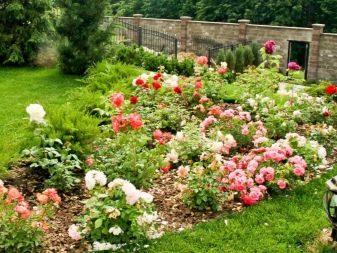
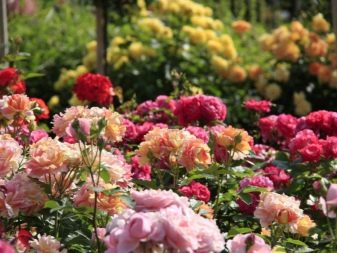
With herbs and grains
Among perennial herbaceous plants, it is worth choosing varieties with bright green or silvery foliage, which will set off bright pink flowers. Of perennials, lavender, veronica, verbena, bells, asters, and alpine phlox are well suited.
Roses look advantageous against the background of spikelets of cereal perennial and annual plants. Against their background, roses play even brighter with colors, and their aroma intensifies. The spikes of cereals give the rose bushes an airiness and ennoble them, creating a decent background.
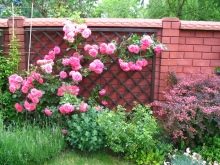

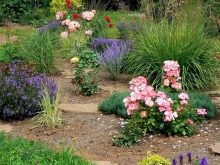
Landing patterns
For a flower bed of roses, various forms are suitable: round, oval, square, rectangular... The flowerbeds, as a rule, are made in the correct geometric shape, and the flowers are planted, creating intricate patterns or designs. The flower garden can be placed both in the center of the site and near the wall. It is better to make the size of the flower bed small so that you can reach every flower on it, otherwise you will have to lay paths, and this does not always look aesthetically pleasing.
Flower beds, framed by a border of stone, ceramics or brick, look beautiful. Low-growing plant species, such as boxwood or sage, can be planted as a frame. Against the background of dark green foliage, bright rose flowers look even more spectacular.
When forming a flower bed, it is better to make a hill in the center, and from it a smooth transition to the edges. In this case, the entire flower bed should rise 10-15 cm above the level of the site.
Roses do not like stagnant moisture in the soil, so you need to provide good drainage in the flower bed or make an elevation.

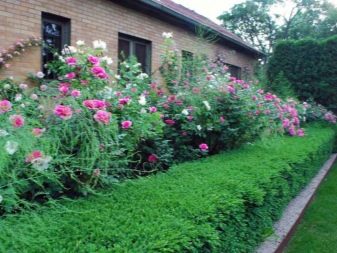
Plant tall varieties of roses in the center of such a flower bed, and less tall plants around the edges. The center of the flower bed will become the accent of the composition; choose a bright color scheme with large buds. And let the framing be gentle and calm. Rose bushes can be diluted with other plants (ornamental grasses). It is not worth planting many roses of various colors on one flower bed at once, 4-5 colors combined with each other will be enough. You can decorate the sides of the flower bed with your own hands. For this, gardeners use improvised materials: stones, stumps, vines, bricks or cinder blocks, plastic or small gravel. To refine the rose garden, you can use various garden figurines of gnomes or funny animals that are sold in stores. So the flower garden will look like a complete composition.
It is better to place a flower bed with roses in a place protected from the wind.... Roses do not like drafts and long exposure to direct sunlight. It is better if the sunlight is in the morning and evening hours, and in the daytime the rose garden is in partial shade from other plants or buildings.
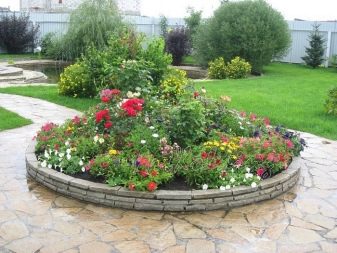

It is best to plant rose bushes in a flower bed in a checkerboard pattern. So each bush will not interfere with the other, and it will be more convenient to care for them. In between the roses, other types of plants are planted. Between small rose bushes, you need to leave 25-30 cm, and between large bushes - at least 50 cm, sometimes the distance reaches 1.5 m.
Placing rose bushes along the hedge will not only decorate the site, but also protect it from the wind and unwanted glances from neighbors and passers-by. Climbing rose bushes tend to grow rapidly and reach a height of more than 1.5 m. The bushes are planted at a distance of about 1 m from each other. In between, you can plant undersized plants of another type or tea roses.
Ground cover roses and tea varieties look great on alpine slides. The combination of roses with stones is very impressive.
For this design, it is best to use fast growing varieties with bright colors.
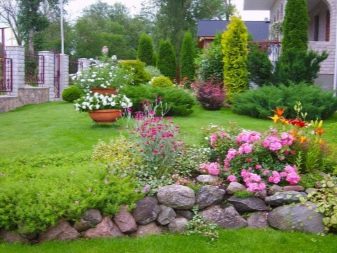
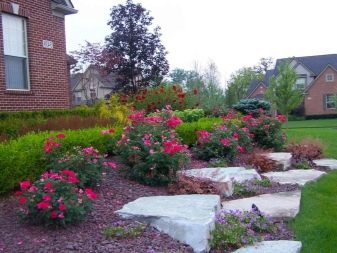
Examples of flower beds in landscape design
A flower garden of climbing roses framing the gazebo.
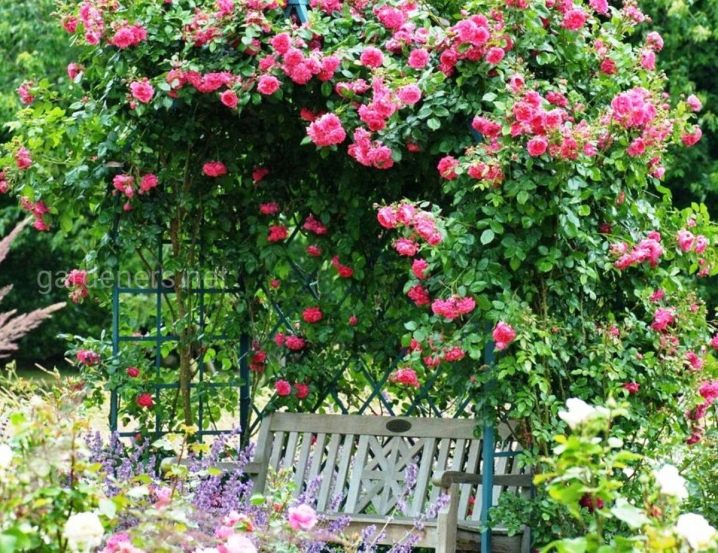
When creating a border, it is best to combine roses with hosta. The lush foliage of the hosta covers the unattractive bottom of the roses and creates a decorative effect.
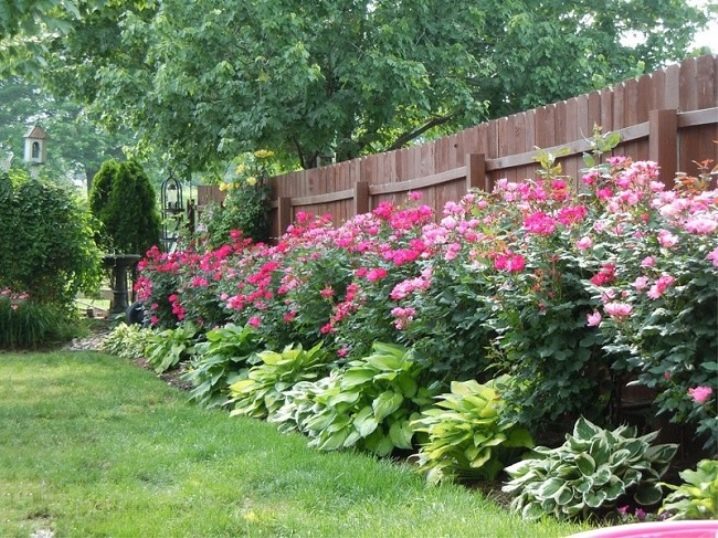
On the alpine slide, a rose garden of ground cover varieties of roses looks spectacular, which quickly grow and cover the entire hill with a green carpet with bright flowers.
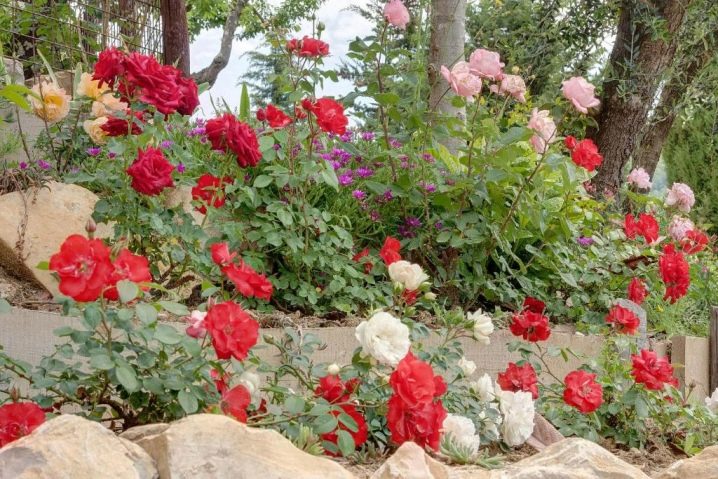
Making a path on a personal plot with the help of hybrid varieties of roses of different heights.


































































































The comment was sent successfully.